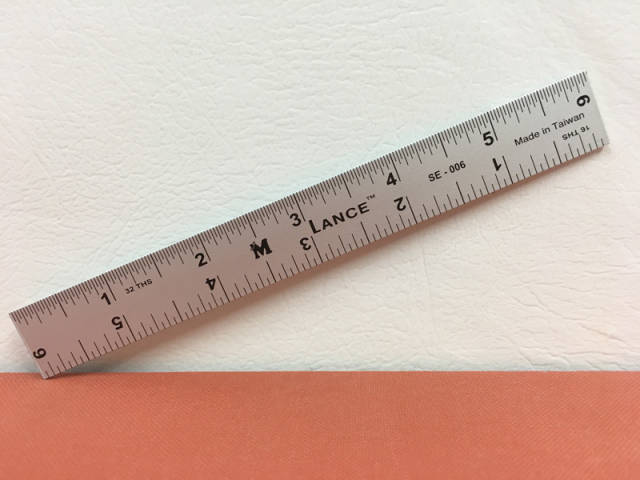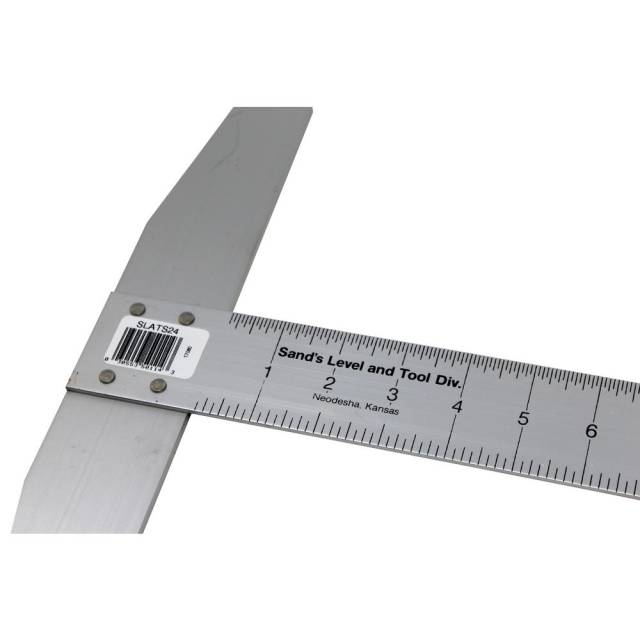MJCD
in over 11 years
Resident Skills
I’ve commented, previously, that a Forum is defined by the skills and mentoring-willingness of its active members. And, there is the other side of that coin, that other members need to be asking the provocative questions to draw-out and provide a context for the active members. I have no idea if others agree with me; but I’ll take a stab at something…
I’m calling on this Forum’s members to discuss what they do well (not a time to be bashful); and to discuss what they need help with: for me, I need help with Finishing and Sharpening; while I do OK with Layout and creating jigs & fixtures to safely and repetitively cut sculpted pieces. I’ve developed a decent skill on the Bandsaw; and don’t particularly relish processing small pieces on the router table. And, I’m very much a newbie when it comes to hand-planing.
For example – my comments on Layout:
I rely on Woodpeckers and Incra layout tools – not many: maybe 4 or 5 well-used squares and rulers – metric (this is by choice, not mandate); as well as a Wixey angle gauge and a 6" digital caliper. The Paoloni Ruler is my go-to mark-up tool. With these tools, I square and true-up all of my machines at the end of – and re-check at the start of – each project.
I use one tape measure (if you use 2, they will be different).
I sweat the details – depending on the subject, 1mm (1/25th") is about as large as I’ll go; for Maloof/Taylor joints, I’m at 10ths of 1mm.
My projects start on an Excel file: every part is numbered; every part is dimensioned; parts that will become a composite are summed; and, that sum has to equal overall dimensions that I specify within the Excel file. The parts schedules follow me to the shop, and are referenced throughout the build. Certainly, there are many nominal dimensions; and it is crucial that you keep track of finished dimensions as you progress through the processing stages. Often, I spread a piece of brown Kraft paper across my workbench, and draw the layout(s) 1:1 scale. Within Excel, I’ll prepare a rudimentary cut-plan.
“Good Enough’ is when the parts fit naturally against each other… I don’t rely on glue or clamps to close gaps, unless there is a specific reason to do so (a board that slightly cups during the build process might be one reason…).
i make jigs that allow me to reference hard surfaces and fine-tune cuts; and, actively work at letting my machines do the cutting, rather then me forcing the bandsaw blade or expecting too much from a sander.
Within all of this are my not-so-professional skills (at using good tools, and jigs, and fixtures); and, the steep learning curve of efficient and effective cut sequences – keeping reference surfaces intact during the build. And, while I’m sweating the small stuff, I can be found cutting the wrong piece; and reversing top & bottom, if I’m doing a Domino operating.
…
So, I’ll the active members to participate in what they do well… and are glad to share with others who may be struggling in an area.
Thanks for reading…
Mike
24 Replies
Have you ever composed a long reply , that took
a long time , and when you hit the ‘submit’ key…
find that you are no longer on line ? VERY annoying !!!!
I will back later to talk about layout tools , in a provocative
manner I hope ……when the connections are less sketchy .
I thought this forum is about advertising revenues …..
I could be wrong ……but naugh……….that’s about it …
just normal commerce . In the woodworking magazines
of the 1960’s some would submit their work through contests or solicitations . Once it was selected the
magazines would pay the woodworker a few bucks ,
in exchange they handed over the piece and it’s proprietary value of design(plans) and reproduction to
the magazine . They would often have bio profiles and
words of wisdom from the " lucky " selectee . this was the backdrop for magazines selling ad space to tool companys and selling those all important " Woodworking
Plans " they had acquired . selling the dream ……ah yes .
I will return to talk about layout tools , and I have a
riddle…..puzzle……a sort of hypothetical contest to test
everyone’s knowledge .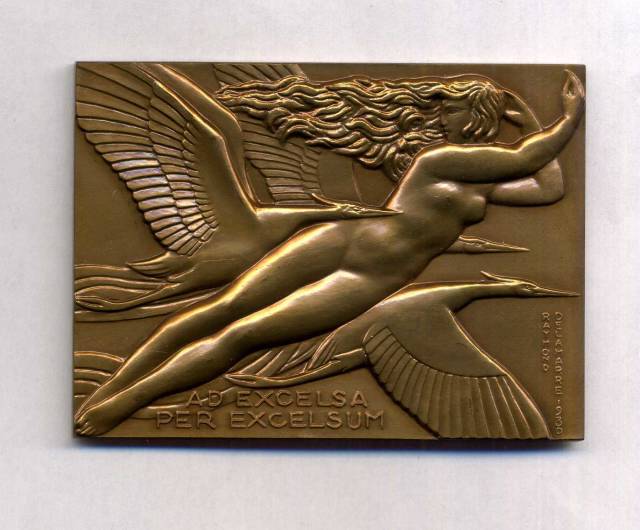
I came up for the idea for this contest a few years ago
while doing layouts for small pieces . After you learn the
contest, you can challenge a woodworking friend to
beat you . It’s good for a laugh or two .
Are you ready to participate ? OK ! Let’s begin .
Each contestant is allowed one pencil or pen.
Each contestant is allowed to bring a combination of
of marking , layout, measuring tool(s) of their choosing .
These tool(s) must be ones you can purchase
from a woodworking supply store .
Rules : The contestant that finishes marking their
their board accurately in the quickest time
wins .
So it is Moment vs. everyone
Scenario : In a room there is a flat table. On this table
are two identical 1×2′s that are 6 inches long.
( Remember that the boards are 3/4 in thick
and 1 1/2 inches wide ).
Before the contest , with your pencil , and measuring
tool(s), and board in front of you , we are instructed
to mark the face of the board into three equal parts
lengthwise .
Then to mark the edge of the board into halves . Very
simple .
Are you ready to beat me ? good . There is a twist .
As soon as the contest begins , the lights are turned off
and it is pitch black . About 15 seconds into the contest,
I will have marked my board accurately . How long do you
think it would take you to mark your board in Darkness ?
The only possibility that you have of beating me or
even completing the contest is if you have brought
the same layout tool(s) that I have .
So the question is : What measuring/marking tool(s)
did I bring, and how did I use it in total darkness ?
Can you Guess ? I will give you a while , before returning
with the solution ,or until someone has figured it out .
good luck .
When playing this contest , when I explain the particulars
of the game , my opponent will balk at the idea of
turning out the lights . " Impossible " they say" to mark
something accurately without being able to see it ."
Then I say “OK , what if I leave the lights On for you ,
and I wear a blindfold ?”
This seems agreeable to them . They then perceive
that condition as one that gives them the advantage .
The advantage I have is setting the divisions of the
layout ( Thirds and Halves ) . The blindfold will make
no difference to me . Considering that you will now
be able to ’ see ’ what you are marking , What layout
tool(s) would you bring ? …and how much time will
it take you ?
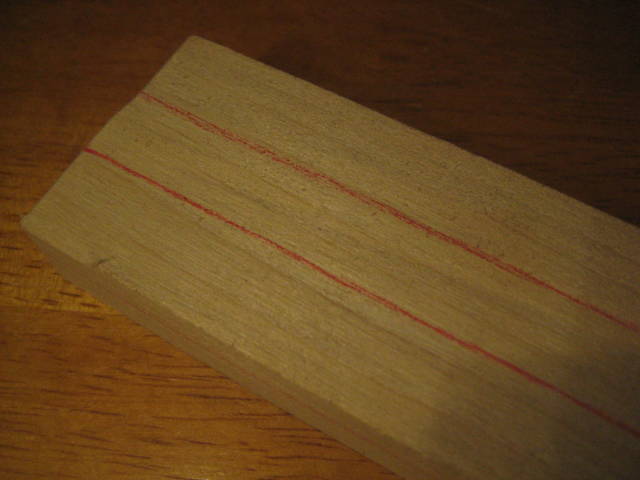 three equal divisions on the face .
three equal divisions on the face .
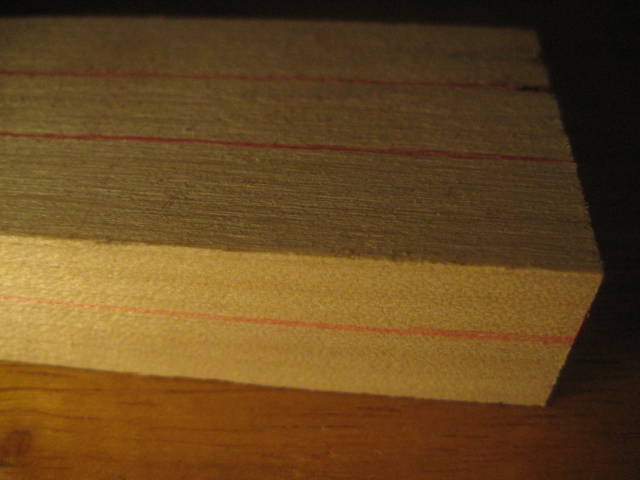 divided in half on the edge .
divided in half on the edge .
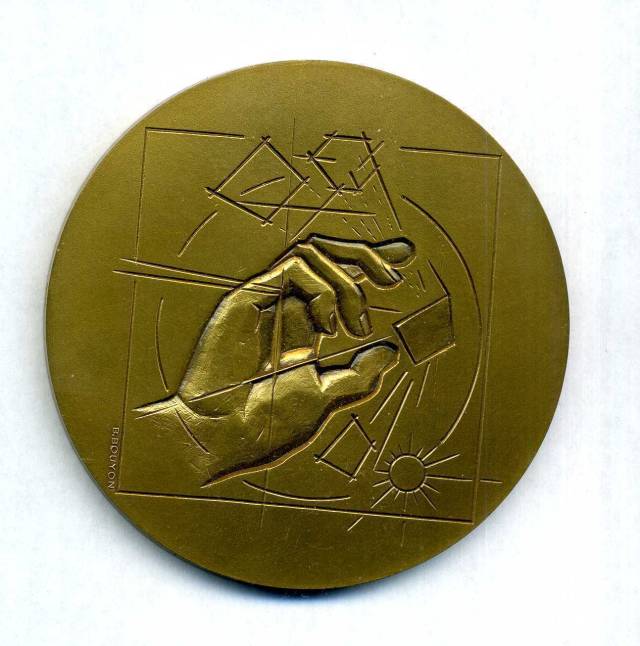
.
.
.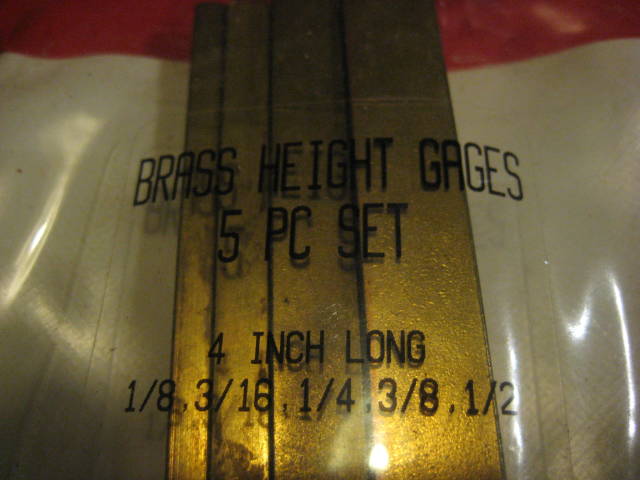
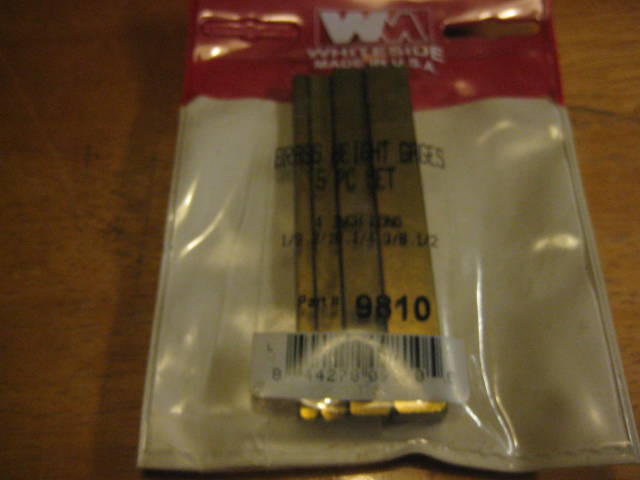
hight gauges , or set up bars . I will use the half inch bar,
and the three eights inch bar.
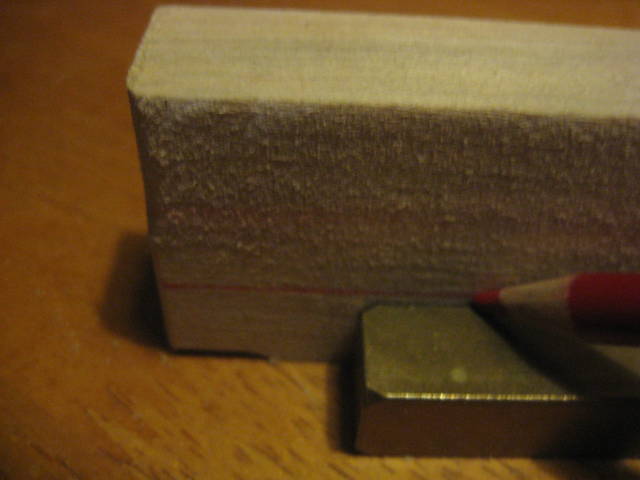
with board on its edge ,I use the 1/2 inch bar and draw
a line .
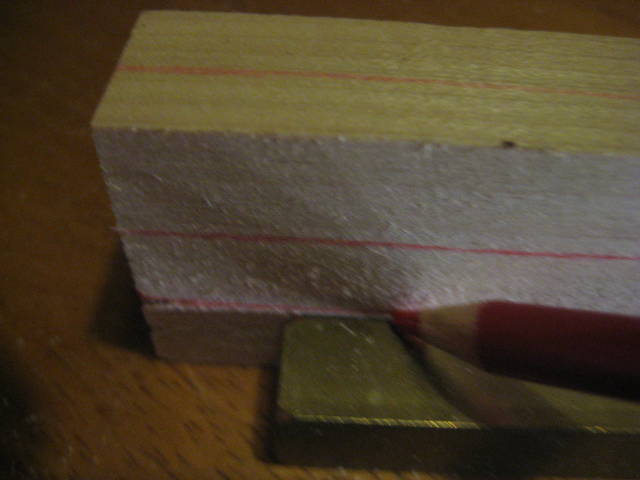
I flip the board 180 degrees and repeat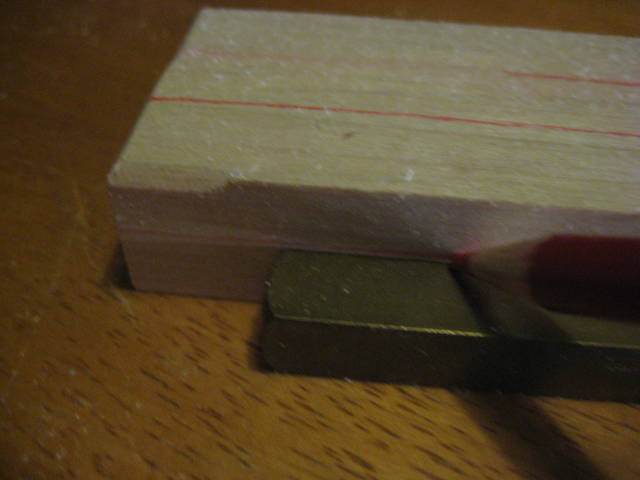
I lay the board flat and use the 3/8 " bar to draw
a line in the same manner to divide it into halves .
Elapsed time is 3 to 5 seconds ….with eyes closed.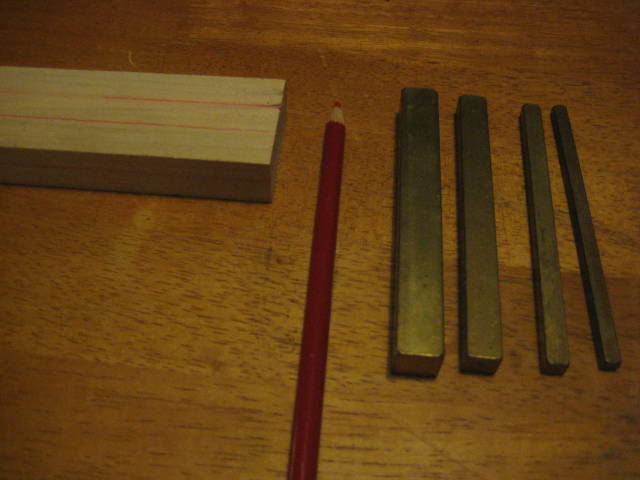
Not such a simple puzzle .
Pretty cool. I work in metric, so that won,t work.
Tor and Odin are the greatest of gods.
Well , when you say it won’t work for you , I can
prove you dead wrong . Accounting for your exclusive
use of metrics , I will give you another chance . Again ,
choose a tool(s) that you can buy from a woodworking
store ( no jigs ) . Pre set it or them to 12.7 mm , and
9.52 mm . Put on your thinking cap . Everyone is welcomed
to participate . I will show you how to beat the set up bars
with metrics . Quite simple . Back later with the solution
and…….hopefully….. a hay stack .
For halfsies I use a combination square, set to approximate half, mark, flip top the other side and mark, and dead center is the midpoint between the marks. Then hold your pencil on the exact midpoint, reset the square to lay against the pencil and zip it down the length. If you’re really anal, do that twice – once from each side – to account for possible width variations. Of all my tools, my little 6" combination square gets the most use when woodworking.
Losing fingers since 1969
Bless you Brian . In all the years I have been on woodworking
forums , you are the only one who has ever asked me a
question about my work (2015) . I really admire the way you
deal with problems in your work , and your solutions .
It’s enjoyable to watch the results .
In this contest , remember, it’s whoever marks the
board accurately and in the Least amount of time wins .
If you have to stop and adjust your combo square, then
you will not do well time-wise . You can use a tool or tools .
I would suggest that you use two combo squares if you
can borrow an extra one . Set one square to 1/2 " ( 12.7 mm )
and the other square to 3/8" ( 9.52 mm ). Have someone time
you and see how fast you are , and return here with your
best time result . The one person who almost beat me at
this contest used this method . He was a few seconds
slower , but he was on the right track .
You may use another tool(s) , if you think of any that
would be faster . Thank you Brian .
( my best time with the set up bars is 2.5 seconds )
I could never win on time. Even if you were blindfolded, in a straight jacket, hanging upside down in glass enclosure filled with water with the lid padlocked (Houdini style). AND EVEN after you give me your marking gauges in advance and an hour lesson and practice session. You would still likely win. At least 51% chance.
Losing fingers since 1969
That is hilarious !!!!!!!!
Funny but true. LOL
By the way I ask questions often. I’m inquisitive enough to steal other people’s ideas. ;-)
Losing fingers since 1969
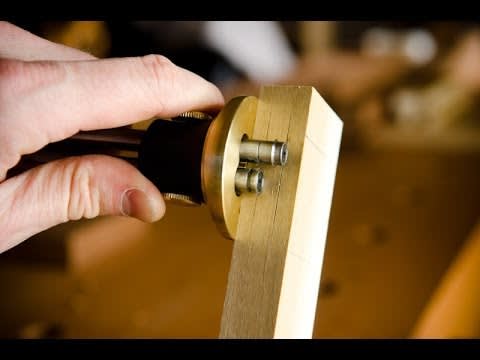
This is a double wheel gage , used to lay out lines for mortises .
I set the outside wheel to 12.7 mm . I set the inside wheel to
9.52 mm . I angle the gage and mark the face with the 12.7 mm
wheel . I angle the gage and mark the edge with the 9.25 wheel .
Elapsed time is just over 1 second , 1.5 seconds max .
Contest closed .
In the Dark?
Tor and Odin are the greatest of gods.
In the Dark?
—Madts
Tor and Odin are the greatest of gods.
No, my friend . it would take a lot longer in the dark .
The wheels are preset . If they were not, I would
surely lose .
This contest is more about looking at a problem
in different ways , not winning or losing . Learning
efficient ways of doing things , novel ways of doing
things…….(even in the dark ) ……keeps your mind
open to new concepts in all your moves forward .
I was lucky to have a strong background in
Drafting early on . I would recommend drafting
courses for someone who is serious about advancing
in their expertise and enjoyment of woodworking .
You should learn and copy anything and
everything you wish . When your skills match your
imagination , you will be able to break free and
develop your own designs……..and your own style .
I have a design in my head for an automatic centering device that is simple and can be used in any lighting situation. 3 narrow bars with a cog between each. The first bar is is stationary and is held against the bottom. The middle is slid toward the center. The top bar necessarily moves at twice the rate as the middle (the cogs are the same size). When the last bar is even with the top, the middle bar is centered. Probably something like this already exists as a marking device.
Or, strap two compasses together that share a spreader rod. One leg has a pivot on the rod, the other 2 legs have cogs of the same size. Same principle. Automatic centering. Bonus: this one works with varying width.
Losing fingers since 1969
I certainly would be interested in seeing your
results if you make it .
Continuing on with layout ………..here is an
obsolete template . You can now do on a computer
anything that you used to do physically with it .
Since I don’t use a computer to design ……the point
is moot with me . I am used to something more
tactile than key strokes …….not that I have the
time or brain power to do drafting on a computer .
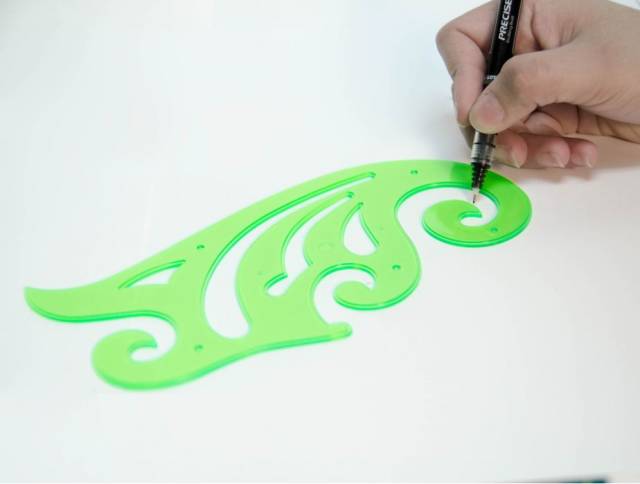
A set of these is a must.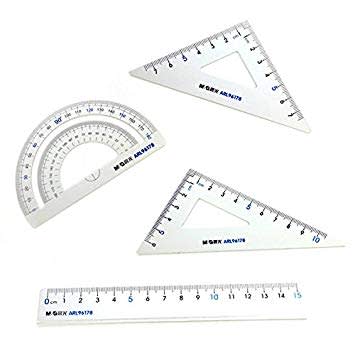
Measuring…………….
I do not use retractable metal tapes in
woodworking . I think the last time I used one ,
I was looking through some sheet goods . I do
use a retractable Cloth tape measure though ,
with Metric on one side . This is always in my pocket
when I am working . Comes in handy in many
situations .
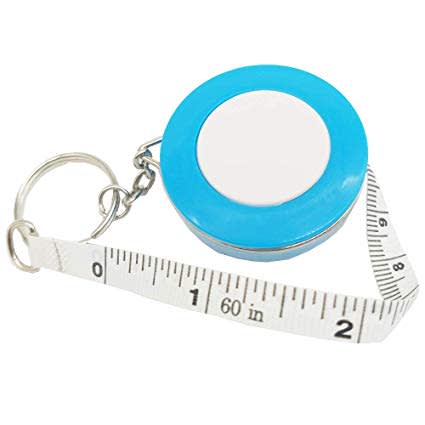
I use aluminum rules , in 2 ft.
increments of 1 to 8 ft .
and T-square rules………that’s about it .
